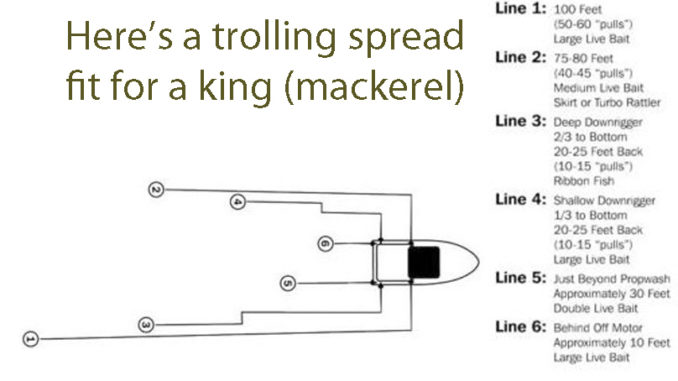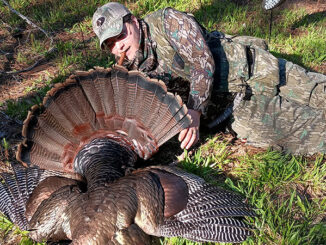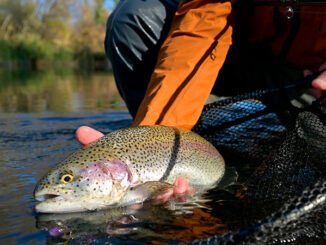
Getting a king mackerel to bite is as simple as feeding it
Everyone wants to know the secrets or hot tips for catching big king mackerel. And they are often initially a little put out when I tell them there aren’t any major secrets. The best tip ever given for catching big kings — and this would undoubtedly work for catching most predator fish — is to put something it likes to eat in front of it when it’s hungry. Often eyes roll and “smart ass” forms on lips. But it is undeniably true.We believe we have what king mackerel like to eat pretty much understood and covered. The difficulty comes with knowing when, where and how to put those baits in the water.
Since we’re discussing larger king mackerel, live bait is the choice. And menhaden are the king of live baits. Some anglers know them by other names — bunker, fatback, shad or pogie — but those are all menhaden.
Almost everywhere has a spot or two to find those big “turbo pogies,” that gather in schools, are usually spotted by flipping fish or diving pelicans and can be caught by the hundreds in cast nets. “Big baits equals big fish” is almost a religion in both Carolinas. And the results usually bear this out.
Some other baits are also productive for king mackerel
Other productive live baits include mullet, bluefish, blue runners, cigar minnows, sardines, gray trout, pinfish, lizardfish and more. On the dead-but-natural-bait side, ribbonfish are prized, and cigar minnows and sardines are frequently used. A select few fishermen have also discovered split-tail mullet and ladyfish.
We have some good ideas on what to feed the fish, but how about when? Several indicators determine when fish will feed. One I really like to use is the Solunar Tables. These tables determine fish and animal feeding times and intensities based on the position and size of the moon. In a nutshell, full and new moons are the most-active phases. And times when the moon is directly overhead or underneath are the best times during the day. Major and minor periods take place each day. And these periods vary in intensity relative to the phase of the moon.
Fish are greatly affected by weather factors such as wind, temperature, humidity and barometric pressure. When the weather has been stable for a few days, the Solunar Tables can be an excellent indicator of feeding periods. But when the weather is changing, it exerts extra influence.
Times of day, tide changes are also factors
Generally accepted as good times to fish are first light, last light, and the first few hours after a tide change. When one of these times is concurrent with a strong Solunar major period, the odds shift to the fisherman’s favor.
As far as where to fish, take internet fishing reports with a grain of salt. Some posters exaggerate greatly, even though most give accurate reports. The best report is from fishing an area yourself. A report from a trusted friend is second.
The final option is how to present baits and that’s where I believe I can really help. While my wife says I am totally anal about this, I begin fishing with a very specific 6-line spread that is designed to use multiple baits and position them at specific locations behind the boat and at specific depths in the water column. This is what I call my “prospecting” spread.
The distances I use are for general placement. You can consider them as relationships rather than absolute measurements. When fishing alone, anglers can expand the spread. And they can also shorten it when fishing in a heavy crowd.
Pay attention to watch patterns develop
I begin with specific baits and rigs in specific places. That helps me understand what baits and rigs are where. And I can adjust the spread when a pattern develops. Patterns will develop during a day on the water And noticing and adjusting to take advantage of them are keys to catching more and larger kings.
With the exception of ribbonfish rigs and double-bait rigs, I use basic rigs including two treble hooks unless the baits are very large. I’ll add additional stinger hooks as needed. For tournaments, I make the rigs using No. 4 single-strand wire. Double and ribbonfish rigs are made from No. 5 single-strand wire. For ribbonfish rigs, I use butterbean bucktails for the nose hook. I feel their flat sides deflect easier and help give the dead baits a little more action. For my prospecting spread, I begin with a single rig with a skirt or rattle. But I may add more later if the fish like it on a certain day or when fishing in dirty water or rough-water situations.
One of the keys to managing spreads of live bait is to begin with the longest line and fill in the spread as you work back towards the boat. Baits school for protection and will swim together if allowed. By making each line shorter, the new baits do not have to swim past baits already in the water. So they rarely tangle.
Set the longest line at 100 feet
The longest line is a big live bait, 100 feet behind the boat, with the rod placed in the starboard rod holder angled out from the T-top.
Some fishermen have difficulty estimating distances, and fish sizes. They can use “pulls” to estimate distances. The term “pull” describes pulling line off between the reel and the first guide. The “pull” of line from the reel to the first guide on most rods is about two feet. So something between 50 and 60 pulls should be around 100 feet. Measure this distance on your own rods to be exact.
The second-longest line uses a live bait and a small skirt or Turbo Rattler. This bait is 75 to 80 feet back. Place it in the port rod holder angled out from the T-top. A skirt works great in clean water. A Turbo Rattler garners more bites from king mackerel in dirty water. Use light colors as long as the water has a green tint. Switch to dark if it has a blue tint.
Now set the remaining lines
Connect the third line out to the deep downrigger on the starboard side. Ribbonfish is the preferred bait, set 20 to 25 feet behind the downrigger release. Lower the downrigger ball two-thirds of the way to the bottom.
Connect the fourth line out to the shallow downrigger on the port side. Use a live bait, set 20 to 25 feet behind the downrigger release. Lower the downrigger ball one-third of the way to the bottom.
Next, rig the fifth and six lines either from the leaning post or transom rod holders. Place them visually rather than by distance. These are the shortest lines on the boat. They rotate as motors are switched on and off while trolling. The longer of these lines is fished behind the motor that is running. Place the shorter behind a motor that has been shut off to slow to trolling speed.
The fifth line uses a double-bait rig and is fished just beyond the prop wash: approximately 30 feet. Menhaden and blue runners seem to do best in the double rig. The sixth line runs behind a motor that is not running. Set it just far enough back not to tangle (around 10 feet). A large menhaden, bluefish or blue runner usually does best on this line.
Adjust the spread as the king mackerel bite dictates
As noted earlier, this is a prospecting spread. Anglers place specific baits at set places. And they know all depths and line lengths. Variables we fishermen cannot always determine move fish to different depths and cause them to be attracted to or hold their distance from boats. Sometimes, fish prefer certain baits. This spread allows us to find and exploit those preferences, even without needing to understand them.
By knowing the location and type of bait on every line in this spread, we can easily make adjustments once a pattern develops. By beginning each day knowing which baits are where in the spread, it is far easier to notice as any feeding patterns form. Once we notice a pattern, it is simply a matter of adjusting the spread to get another similar bait in the same approximate location. And this should increase the probability of catching more and larger fish.
If the first several strikes come on the longest line, simply drop it back a little farther and place the next longest line just shy of where the first one was. When strikes are coming on one of the downrigger lines, just move it up or down a little to make room and adjust the other one up or down to position it near the same approximate depth. Simply adjust the spread to get a second line and bait in the area where the fish are feeding.
Catching lots of big king mackerel is simply a matter of putting a bait they like to eat in front of them while they are hungry. You’ll have to obtain the bait and find the fish. But this should give you some insight on the best times, best baits and a good trolling spread to draw lots of strikes.





Be the first to comment